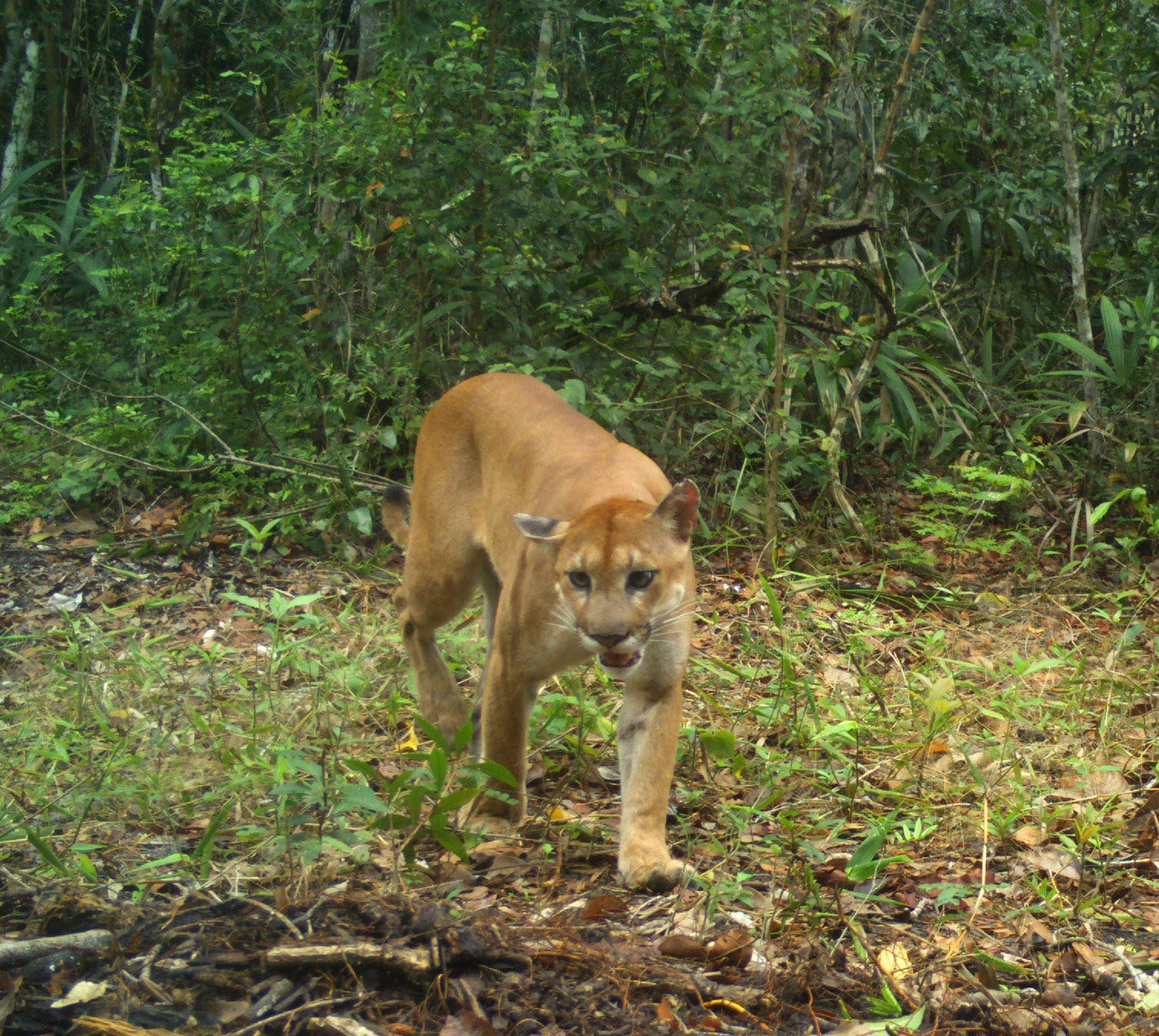Abstract
The connectivity of 16 protected areas and their biological corridors in the western region of Honduras was evaluated, using the puma (Puma concolor) as an indicator species. The landscape metrics used to measure connectivity were the Connectivity Integrity Index (IIC), the Probability of Connectivity (PC) and the Modularity (Mod). The results showed 131 fragments and 345 links with low probability of connectivity for this species. The best connectivity between protected areas and corridors for the movement of the puma, according to the metrics used, were Celaque National Park (PN) and Opalaca Biological Reserve (RB) protected areas. The areas that showed low IIC and PC are: Cerro Azul PN, Copán Ruinas Archaeological Park (PA), Erapuca Wildlife Refuge (RVS), Montecristo PN, Güisayote RB and El Pital. The conservation of the puma depends mainly on maintaining protected areas, biological corridors, as well as the use of other unprotected areas that help maintain the integrity and faunal composition in western Honduras.
References
Andrade, A.P. 2007. Aplicación del Enfoque Ecosistémico en Latinoamérica. CEM-UICN. Bogotá, Colombia.
Alves-Pinto, H., J. Geldmannd, H. Jonas, V. Maioli, A. Balmford, A.E. Latawiec, R. Crouzeilles y B. Strassburg. 2021. Opportunities and challenges of other effective area-based conservation measures (OECMs) for biodiversity conservation. Perspectives in Ecology and Conservation. 19(2021): 115–120. [https://doi.org/10.1016/j.pecon.2021.01.004]
Allen, M.L., L.M. Elbroch, C.C. Wilmers y H.U. Wittmer. 2015. The comparative effects of large carnivores on the acquisition of carrion by scavengers. American Naturalist, 185:822-833.
Barry. J.M., L.M. Elbroch, M.E. Aiello, L. Ronald, S.J. Lisa, S. Anna, H.B. Quigley y M.M. Grigione. 2019. Pumas as ecosystem engineers: ungulate carcasses support beetle assemblages in the Greater Yellowstone Ecosystem. Oecologia,189:577-586.
Bennett, A.F. 1999. Linkages in the landscape: the role of corridors and connectivity in wildlife conservation. Conserving Forest Ecosystems Series No. 1. International Union for Conservation of Nature and Natural Resources (IUCN). Gland, Suiza y Cambridge, Reino Unido.
Bennett, A.F. 2004. Enlazando el paisaje: el papel de los corredores y la conectividad en la conservación de la vida silvestre. Serie Conservando los Ecosistemas Boscosos No.1. International Union for Conservation of Nature and Natural Resources (IUCN). San José, Costa Rica.
Bennett, A.F. y K. J. Molungoy. 2006. Review of experience with ecological networks, corridors, and buffer zones. CBD Technical Series No. 23. Secretariat of the Convention on Biological Diversity. Montreal, Canadá.
Beier, P. 1993. Determining the minimum habitat areas and habitat corridors for cougars. Conservation Biology, 7:94-108.
Beier, P. 2012. Conceptualizing and Designing Corridors for Climate Change. Ecological Restoration, 30:312-319. [https://doi.org/10.3368/er.30.4.312]
Bump, J.K., R.O. Peterson y J.A. Vucetich. 2009. Wolves modulate soil nutrient heterogeneity and foliar nitrogen by configuring the distribution of ungulate carcasses. Ecology, 90:3159-3167.
CBM. 2002. Corredor Biológico Mesoamericano: una plataforma para el desarrollo sostenible regional. Serie Técnica 01. Proyecto para la Consolidación del Corredor Biológico Mesoamericano. Managua, Nicaragua.
Cuesta-Rios, E.Y. 2020. Evidencia de la conectividad ecológica del cerro Tacarcuna, expresada en la presencia y distribución de mamíferos terrestres neotropicales. Revista Bioetnia, 8:155-162. [https://doi.org/10.51641/bioetnia.v8i2.42]
Clauzel, C., J.C. Foltête, X. Girardet y G. Vuidel. 2019. Graphab 2.4 User Manual. [Internet]. Disponible en: <https://sourcesup.renater.fr/ www/graphab/download/manual-2.4-en.pdf.> . [Consultado ].
Castañeda, F.E., N.P. Mccann y H.D. Á-Palma. 2022. Confirmed presence of a puma in the binational Merendón Mountain Range. CATnews, 77 .
Esparza-Carlos, J., J.L. Peña Mondragón y A.L. Hoogesteijn. 2022. Los jaguares y pumas no son devoradores de humanos. Therya, 1:20-22.
Elbroch, L.M., C. O’Malley, M. Peziol y H.B. Quigley. 2017. Vertebrate diversity benefiting from carrion provided by pumas and other subordinate, apex felids. Biological Conservation, 215:123-131.
Emmons, L. H. 1991. Neotropical rainforest mammals. A field guide. The University of Chicago Press.
Franklin, J.F. y D. Lindenmayer. 2009. Importance of matrix habitats in maintaining biological diversity. Proceedings of the National Academy of Sciences, 106:349-350.
Foltête, J.C., C. Clauzel y G.A. Vuidel. 2012. A software tool dedicated to the modelling of landscape networks. Environmental Modeling and Software, 38, 316-327.
Harrison, S. y E. Bruna. 1999. Habitat fragmentation and large-scale conservation: what do we know for sure?. Ecography, 22:225-232.
Iriarte, J.A., W.L. Franklin, W.E. Johnson y K.H. Redford. 1990. Biogeographic variation of food habits and body size of the America puma. Oecologia, 85:185-190.
ICF. 2013. Estrategia para la Consolidación de Corredores Biológicos de Honduras (ECCBH). Departamento de Áreas Protegidas/ Instituto Nacional de Conservación y Desarrollo Forestal, Áreas Protegidas y Vida Silvestre. Tegucigalpa, Honduras.
ICF. 2014. Mapa de Uso Forestal de Honduras. Tegucigalpa, Honduras.
Kappelle, M., M.M. Vuuren Van y P. Baas. 1999. Effects of climate change on biodiversity: A review and identification of key research issues. Biodiversity and Conservation, 8:1383-1397.
Milanesi, P., R. Holderegger, R. Caniglia, E. Fabbri, M. Galaverni y E. Randi. 2017. Expert-based versus habitat-suitability models to develop resistance surfaces in landscape genetics. Oecologia, 183:67-79.
Miller, K., E. Chang y N. Johnson. 2001. Defining the common ground for the Mesoamerican Biological Corridor. World Resources Institute, Washington, Estado Unidos.
Nielsen, C.D., M. Thompson, M. Kelly y C.A. Lopez-Gonzalez. 2017. Puma concolor. The IUCN Red List of Threatened Species, 8235:12.
Paton, P.W.C. 1994. The effect of edge on avian nest success: how strong is the evidence?. Conservation Biology, 8:17-26.
Portillo-Reyes, H.O y F. Elvir-Valle. 2022. Datos preliminares de los registros de puma (Puma concolor) y su posible distribución en Honduras. Revista Mexicana de Mastozoología, nueva época, 12(1):22-32. [https://doi.org/10.22201/ie.20074484e.2022.12.1.351]
Prăvălie, R. 2018. Major perturbations in the Earth’s forest ecosystems. Possible implications for global warming. Earth-Science Reviews, 185:544-571. [https://doi.org/10.1016/j.earscirev.2018.06.010]
Primarck, R.R., R. Rozzi, R. Feinsinger, P.R. Dirzo y R. Massardo. 1998. Fundamentos de conservación biológica: perspectivas latinoamericanas. Fondo de Cultura Económica, México, D.F.
Preisser, E.L., J.L. Orrock y O.J. Schmitz. 2007. Predator hunting mode and habitat domain alter nonconsumptive effects in predator-prey interactions. Ecology, 88:2744-2751.
Prugh, L.R. y K.J. Sivy. 2020. Enemies with benefits: integrating positive and negative interactions among terrestrial carnivores. Ecology Letters, 23:902-918.
QGIS.org. 2022. Sistema de Información Geográfica QGIS . Proyecto de Fundación Geoespacial de Código Abierto. [Disponible en: http://qgis.org]
Rawat, U. y N. Agarwal. 2015. Biodiversity: Concept, threats and conservation. Environments
conservation. Environment Conservation Journal, 16:19-28. [https://doi.org/10.36953/ECJ.2015.16303]
Sánchez, K., F. Aguilar, D. Donaire, J. Coll, W. Arauz, Y. Andrade, M.A. Carias y W. Gómez-Corea. 2023. Puma concolor: first photagraphic record in the El Jilguero Reserve Water Production Zone, Honduras. Therya Notes, 4: 242-248. [https//Doi: 10.12933/therya_notes-23-136]
Saunders, D.A., R.J. Hobbs y C.R. Margules. 1991. Biological consequences of ecosystem fragmentation: a review. Conservation Biology, 5:18-32.
Sebastián-González, E., Z. Morales-Reyes, F. Botella, L. Naves-Alegre, J.M. Pérez-García y P. Mateo-Tomás. 2020. Network structure of vertebrate scavenger assemblages at the global scale: drivers and ecosystem functioning implications. Ecography, 43:1143-1155.
Sheriff, M.J., C.J. Krebs y R. Boonstra. 2009. The sensitive hare: sublethal effects of predator stress on reproduction in snowshoe hares. Journal of Animal Ecology, 78:1249-1258.
Wilson, E.E. y E.M. Wolkovich. 2011. Scavenging: how carnivores and carrion structure communities. Trends in Ecology and Evolution, 26:129-135.

This work is licensed under a Creative Commons Attribution-NonCommercial-NoDerivatives 4.0 International License.
Copyright (c) 2023 UNIVERSIDAD NACIONAL AUTÓNOMA DE MÉXICO




